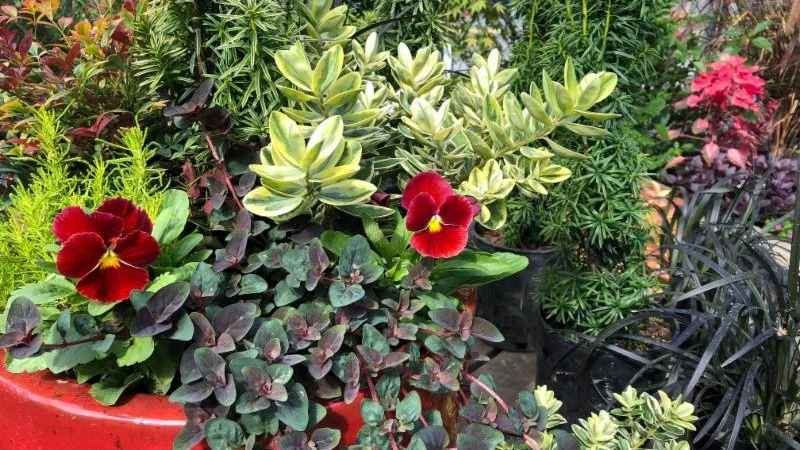I recently read an article on designing with foliage in the garden by a local authors, Christina Salwitz & Karen Chapman. They written two books: “Fine Foliage” from St. Lynn’s Press and “Gardening with Foliage First” from Timber Press - I highly recommend reading both of them. Their main point is that while flowers are ephemeral, foliage can last all season and therefore should be the first consideration in any garden design - be it in the landscape or simply in our containers. As we move into the fall and winter season, their talking points become even more relevant considering that there are fewer and fewer blooming plants to choose from. Here are some thoughts on creating interesting container plantings for the winter…
First and foremost, ditch the earth tone pots and replace them with vibrant colors. There is enough grey in the sky without reinforcing it with similar colored pots. Lime green, blood red, dark blues and even orange will all “pop” in your garden during the dark days of winter. As a bonus, you can often find pots on sale in September so the money you save can be put into interesting plants.
Once you’ve committed to a new and exciting color, start looking for the center piece of your new arrangement. Evergreen ornamental grasses, such as the many forms of sedges, will look fabulous all winter long. Upright growing evergreens, like Sky Pencil Japanese Holly, Irish Juniper or Lemon Cypress, will work as well. For larger pots try a Camellia, Fatsia, or some clumping bamboo.
For some filler I prefer hardy evergreen perennials and broadleaf evergreen shrubs, such as Bergenia, Euphorbia, Heuchera, Leucothoe, Wintergreen, Skimmia, Sarcococca, or ferns. Short grasses, like black Mondo or yellow Japanese Sweet flag, make good fillers too. Garden centers bring in “starter” shrubs in 4 inch pots that are the perfect size for containers.
A few hardy evergreen groundcovers will provide the “trailing” component of your container planting, so try some nonaggressive ornamental ivies, trailing Euonymus, wire vine or creeping Jenny.
One of the beautiful things about winter containers is that we don’t have to worry about sun or shade, so we can combine sun-loving and shade-loving plants into the same container and they will be just fine. In the spring when we dissemble the arrangement, we simply put the plants into the appropriate areas of our garden. Another little trick is to take twigs of contorted willow or red twig dogwood (without roots) and just shove them into the soil as accents. Often by spring they will have rooted and will be ready for transplanting somewhere else. Of course, pieces of art or garden ornamentation make for nice accents too.
While your focus should be on foliage, don’t be afraid to use some seasonal color, like mums, asters, pansies, or violas. You can always replace them later in the fall once they have faded. As far as maintenance is concerned, as long as you use some fresh potting soil and apply a little fertilizer the first month you should be good to go for the whole winter.
To make your life easier, most garden centers have already collected and brought together all of these wonderful winter interest plants into one location for your shopping pleasure and even created several sample plantings to show you how they all work together. It’s totally painless!
So go ahead, rip out those tired summer annuals and surprise yourself this fall with a long-lasting winter interest planter. You will be glad you did and quite possibly become the envy of your neighborhood.




